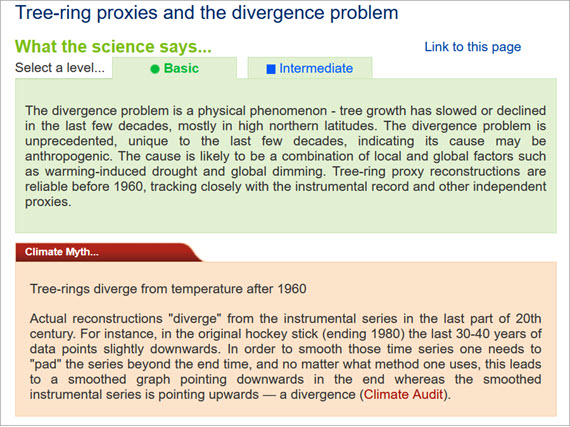
On February 14, 2023 we announced our Rebuttal Update Project. This included an ask for feedback about the added "At a glance" section in the updated basic rebuttal versions. This weekly blog post series highlights this new section of one of the updated basic rebuttal versions and serves as a "bump" for our ask. This week features "Tree-ring proxies and the divergence problem". More will follow in the upcoming weeks. Please follow the Further Reading link at the bottom to read the full rebuttal and to join the discussion in the comment thread there.
"Trees tell of past climates: but are they speaking less clearly today?" That was the intriguing title of a paper published in the peer-reviewed journal, Philosophical Transactions of the Royal Society of London, in 1998. The authors discussed various aspects of the use of tree-rings as representatives - or proxies - of past climatic patterns.
Tree growth is sensitive to temperature. Because of that, warmer wetter periods produce wider tree-ring patterns. When it's colder and dryer, the rings are narrower, indicating slow growth. In this way, the width and density of tree-rings in ancient trees serve as a proxy for temperature. That makes it possible to reconstruct temperature records going back over many centuries. For example, historic events such as major volcanic explosions tend to lead to global cooling. Such events show up very well in tree-ring reconstructions.
In more recent times, since the late 19th century, we also have the observational temperature record to compare with tree-ring reconstructions. Agreement between the two datasets is at first close. However, in middle and especially high latitude sites, the correlation breaks down after 1960. At this point, while temperatures rise, tree-ring width shows a falling trend - a decline. This divergence between temperature and tree growth is called, imaginatively enough, the divergence problem.
The decline, or divergence problem had been recognised, regularly discussed and written about since around 1995. That's 14 years before anyone had ever heard of 'climategate' and the song and dance that the science–deniers made of 'hide the decline'. If anything should serve as a quality-control alert for the output of science-deniers, it's right there.
Now, everything that happens has a cause, but not all causes are straightforward. There are plenty of ways to put stress on plants and stress makes growth-patterns abnormal. The trouble is that such stress-factors often vary in an irregular fashion and independently of one another. Even in a 2023 paper, the detailed cause of the divergence problem was described as being accompanied by 'significant controversies'. It's real, but it's complicated, in other words.
Temperature-induced drought stress and changes in seasonality are likely to be relevant here. Also likely to have had a role is the phenomenon of ‘Arctic dimming'. The term 'dimming' refers to reduced sunshine reaching the surface in some circumpolar regions, due to industrial aerosol pollution. Northern Hemisphere pollution tends to accumulate over the Arctic. Reduced sunshine affects photosynthesis and in return that impacts upon plant health and growth. Indeed, a 2021 paper ominously commented that the effects of Arctic aerosols on net primary production - growth - were particularly important in light of the current race to exploit natural resources north of the Arctic circle.
The extensive boreal forests of the north play a major role in shaping Earth’s carbon cycle and climate system. In the divergence problem, they have raised a red flag. Something up there is wrong and it should come as no surprise that, once again, our reckless misuse of our planet is high on the list of suspects for that.
Please use this form to provide feedback about this new "At a glance" section. Read a more technical version below or dig deeper via the tabs above!
In case you'd like to explore more of our recently updated rebuttals, here are the links to all of them:
If you think that projects like these rebuttal updates are a good idea, please visit our support page to contribute!
Posted by John Mason on Tuesday, 7 May, 2024
 |
The Skeptical Science website by Skeptical Science is licensed under a Creative Commons Attribution 3.0 Unported License. |